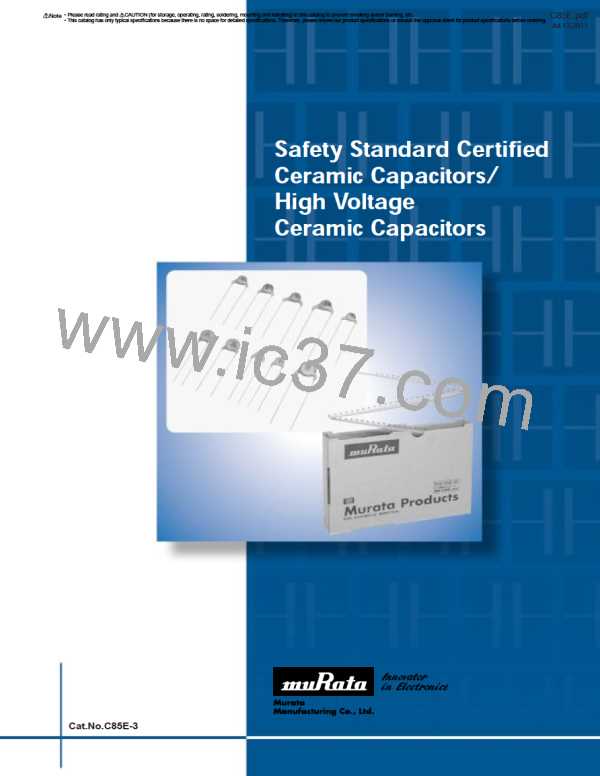• Please read rating and !CAUTION (for storage, operating, rating, soldering, mounting and handling) in this catalog to prevent smoking and/or burning, etc.
• This catalog has only typical specifications because there is no space for detailed specifications. Therefore, please review our product specifications or consult the approval sheet for product specifications before ordering.
!Note
C85E.pdf
Jul.13,2011
DEB Series (Class2 / DC1kV-3.15kV) DSEpeBcSifeicraietisoSnspeacnidficTaetsiotnMseathnoddTsest Methods
No.
1
Item
Specifications
Test Method
Operating Temperature Range
-25 to +85°C
No visible defect, and dimensions are
within specified range.
The capacitor should be visually inspected for evidence of
defect. Dimensions should be measured with slide calipers.
2
3
Appearance and Dimensions
Marking
To be easily legible
The capacitor should be visually inspected.
The capacitor should not be damaged when DC voltage of
200% of the rated voltage is applied between the lead wires for
1 to 5 sec. (Charge/Discharge currentV50mA)
Between Lead
Wires
No failure
The capacitor is placed in the container
with metal balls of diameter 1mm so that
each lead wire, short circuited, is kept
about 2mm off the metal balls as shown in
Dielectric
Strength
4
Body Insulation
No failure
About 2mm
the figure at right, and DC voltage of 1.3kV
is applied for 1 to 5 sec. between capacitor
Metal balls
lead wires and metal balls.
(Charge/Discharge currentV50mA)
Insulation
Resistance (I.R.) Wires
Between Lead
The insulation resistance should be measured with
DC500±50V within 60±5 sec. of charging.
5
6
7
10000MΩ min.
The capacitance should be measured at 20°C with 1±0.2kHz
and AC5V(r.m.s.) max.
Capacitance
Within specified tolerance
Char. B, E: 2.5% max.
Char. F: 5.0% max.
The dissipation factor should be measured at 20°C with
1±0.2kHz and AC5V(r.m.s.) max.
Dissipation Factor (D.F.)
Char. B: Within ±10%
Char. E: Within +20/-55%
Char. F: Within +30/-80%
The capacitance measurement should be made at each step
specified in the Table.
8
Temperature Characteristics
Pre-treatment: Capacitor should be stored at 85±2°C for 1 hr., then placed at
room condition* for 24±2 hrs. before measurements.
Step
1
2
3
4
5
Temp. (°C)
20±2
-25±3
20±2
85±2
20±2
As shown in the figure at right, fix the body of
the capacitor and apply a tensile weight
gradually to each lead wire in the radial
direction of the capacitor up to 10N (5N for
lead diameter 0.5mm), and keep it for 10±1
sec.
Pull
W
9
Lead wire should not be cut off.
Capacitor should not be broken.
9
Strength of Lead
Each lead wire should be subjected to 5N (2.5N for lead
diameter 0.5mm) of weight and bent 90° at the point of egress,
in one direction, then returned to its original position and bent
90° in the opposite direction at the rate of one bend in 2 to 3
sec.
Bending
Appearance
No marked defect
The capacitor should be firmly soldered to the supporting lead
wire and vibrated at a frequency range of 10 to 55Hz, 1.5mm in
total amplitude, with about a 1-minute rate of vibration change
from 10Hz to 55Hz and back to 10Hz. Apply for a total of 6 hrs.,
2 hrs. each in 3 mutually perpendicular directions.
Capacitance
D.F.
Within specified tolerance
Vibration
Resistance
10
Char. B, E: 2.5% max.
Char. F: 5.0% max.
The lead wire of a capacitor should be dipped into a ethanol
solution of 25wt% rosin and then into molten solder for 2±0.5
sec. In both cases the depth of dipping is up to about 1.5 to
2mm from the root of lead wires.
Temp. of solder: Lead Free Solder (Sn-3Ag-0.5Cu) 245±5°C
H63 Eutectic Solder 235±5°C
Lead wire should be soldered with
uniform coating on the axial direction
over 3/4 of the circumferential direction.
11 Solderability of Leads
Appearance
No marked defect
The lead wire should be immersed into the melted solder of
350±10°C (Body of ø5mm and under: 270±5°C) up to about 1.5
to 2mm from the main body for 3.5±0.5 sec.
(Body of ø5mm and under: 5±0.5 sec.)
Pre-treatment: Capacitor should be stored at 85±2°C for 1 hr.,
then placed at room condition* for 24±2 hrs.
before initial measurements.
Char. B: Within ±5%
Char. E: Within ±15%
Char. F: Within ±20%
Capacitance
Change
Soldering Effect
(Non-Preheat)
12
Dielectric Strength
(Between Lead
Wires)
Per item 4.
Post-treatment: Capacitor should be stored for 4 to 24 hrs. at
room condition.*
* "Room condition" Temperature: 15 to 35°C, Relative humidity: 45 to 75%, Atmospheric pressure: 86 to 106kPa
Continued on the following page.
47

 MURATA [ muRata ]
MURATA [ muRata ]